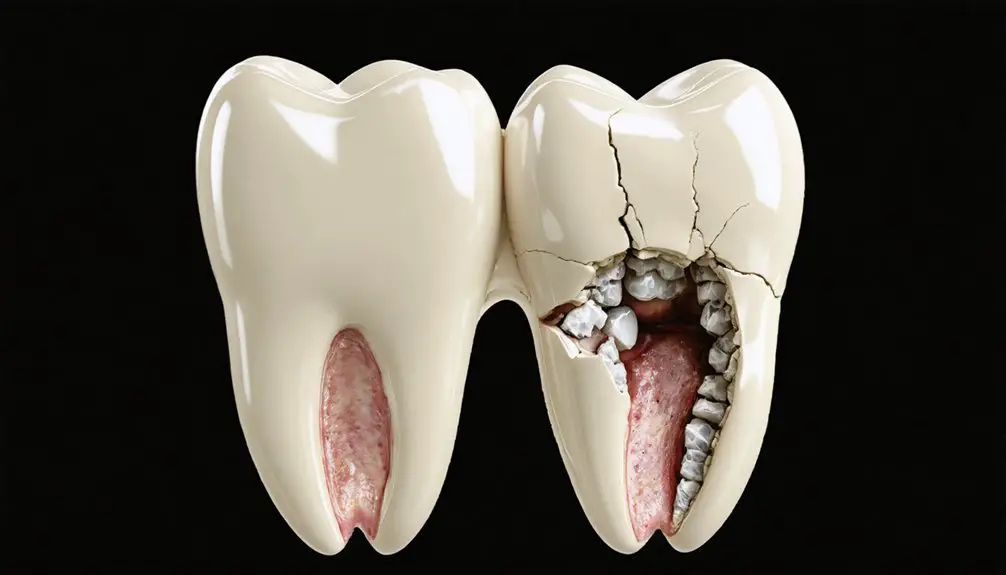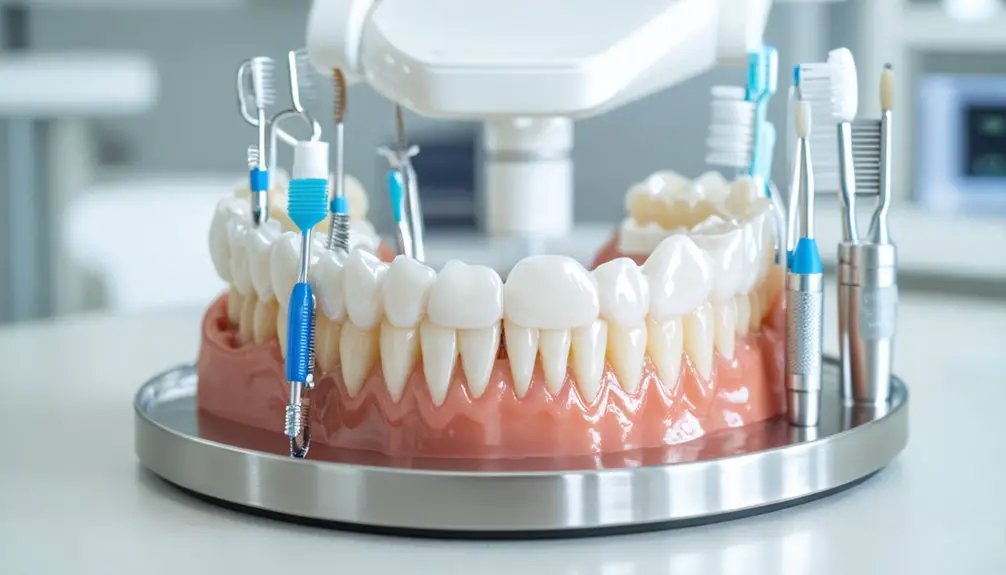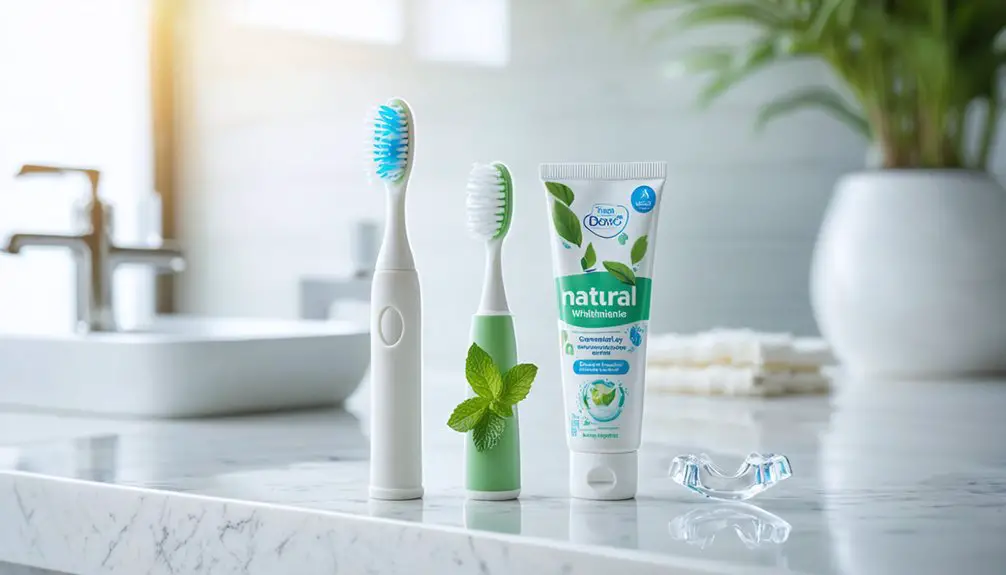Teeth whitening can considerably increase your cavity risk by altering your enamel’s mineral composition and creating microscopic pores. The bleaching agents interact with plaque acids, accelerating demineralization and making your teeth more vulnerable to decay. If you have existing cavities, whitening treatments may worsen the condition due to enhanced bacterial penetration. Professional supervision and a thorough dental examination before treatment can help identify potential complications and determine your safest whitening options.
Key Takeaways
- Whitening treatments can accelerate cavity progression by creating microscopic pores in enamel, allowing deeper bacterial acid penetration.
- Bleaching agents reduce calcium and fluoride content in tooth enamel, increasing vulnerability to decay and cavity formation.
- Oxidative stress from whitening temporarily weakens enamel structure, making teeth more susceptible to acid attacks and cavity development.
- Untreated cavities exposed to whitening agents may experience increased sensitivity and faster deterioration of tooth structure.
- Whitening chemicals interact with plaque acids to create an environment that speeds up enamel demineralization and cavity formation.
Understanding Enamel Mineral Changes During Whitening
While teeth whitening treatments can effectively brighten your smile, they markedly alter the mineral composition of tooth enamel. The process triggers significant reductions in calcium and fluoride content, particularly affecting the outermost enamel layers.
Teeth whitening effectively brightens teeth but significantly changes enamel composition, reducing vital minerals like calcium and fluoride in surface layers.
As whitening protocols progress, you’ll experience increased enamel demineralization, especially with higher concentrations of hydrogen peroxide (25%-35%). Low-rated over-the-counter products can cause severe surface pitting of the enamel.
The mineral loss creates concerning changes in your enamel’s structure. As calcium depletes, your enamel becomes more permeable, incorporating higher levels of organic material and water. This transformation weakens the protective barrier of your teeth. Toothpastes containing salt and lemon components show the most severe enamel surface alterations and mineral loss.
The severity of these changes correlates directly with the peroxide concentration in the whitening product you use. Understanding these mineral alterations is essential, as they can impact your long-term oral health and increase susceptibility to acid damage.
The Science Behind Cavity Formation and Bleaching Agents
Because bleaching agents fundamentally alter your tooth’s microstructure, understanding their interaction with cavity formation becomes essential for safe whitening practices.
When you expose your teeth to bleaching agents, they release reactive oxygen species that can affect your enamel‘s susceptibility to tooth decay. Understanding the tooth’s three distinct layers helps explain how whitening agents penetrate and impact dental health.
- Bleaching interactions create microscopic pores in your enamel, potentially increasing bacterial acid penetration and cavity risk.
- Your tooth’s chemical environment changes as bleaching agents combine with plaque acids, possibly accelerating enamel demineralization.
- The oxidative stress from whitening may weaken your enamel structure temporarily, making it more vulnerable to acid attacks.
- Your teeth’s increased porosity post-bleaching could lead to greater plaque adherence, raising your risk of cavity development if proper oral hygiene isn’t maintained.
The primary whitening agent hydrogen peroxide breaks down chromogens in your teeth while simultaneously affecting the enamel’s surface properties.
Professional vs. At-Home Whitening Effects on Tooth Decay
When you’re considering teeth whitening options, professional treatments offer considerably safer protocols through controlled peroxide concentrations and pre-treatment cavity assessments that protect your dental health. Bleaching agents oxidize surface stains while brightening natural tooth color when properly administered.
Your dentist’s supervision guarantees proper isolation of decay-prone areas and careful monitoring of bleaching agent contact time to prevent enamel damage. Thorough examination ensures that untreated cavities are addressed before any whitening procedures begin.
In contrast, at-home whitening methods carry higher risks of sensitivity and decay progression due to variable peroxide concentrations, improper application, and lack of professional oversight of existing dental conditions.
Professional Treatment Safety Guidelines
As professional teeth whitening treatments continue to evolve, adherence to strict safety guidelines has become paramount for ideal results and minimal complications. Your initial professional consultation will determine if you’re a suitable candidate, particularly if you have existing dental work or sensitivity issues. Professional whitening agents are designed to remove surface stains while preserving tooth structure.
- You’ll need a thorough dental assessment before treatment to identify potential risks, including cavities, exposed roots, or worn enamel.
- Your dentist will customize the whitening concentration based on your oral health status and sensitivity levels.
- Professional supervision guarantees proper application techniques and minimizes gum irritation.
- You’ll receive specific post-treatment care instructions to manage sensitivity and maintain results.
Following these safety measures considerably reduces your risk of complications while maximizing the effectiveness of your whitening treatment, especially compared to unsupervised at-home alternatives. The use of ADA-approved products is essential for ensuring both safety and effectiveness during professional whitening procedures.
Home Whitening Risk Assessment
While professional teeth whitening treatments involve thorough dental evaluations, at-home whitening methods can pose significant risks to oral health, particularly in the presence of untreated cavities.
When you’re considering home care whitening alternatives, it’s important to understand that bleaching agents can penetrate cavities and reach sensitive inner tooth layers. These chemicals may accelerate decay and increase your risk of infection, especially with poorly fitted trays or strips that allow up to 50% leakage onto soft tissues.
You’ll face heightened sensitivity risks, with approximately 67% of patients experiencing discomfort. The hydrogen peroxide or carbamide peroxide in whitening products can damage your tooth’s organic matrix and enamel structure, potentially leading to surface roughness and erosion. Dental caries require immediate treatment before considering any whitening procedures to prevent further complications.
Without professional oversight, you might overlook active cavities, resulting in more severe dental complications requiring extensive treatment.
Detecting Early Signs of Enamel Damage
You’ll notice clear visual indicators of enamel deterioration through yellowing, dullness, or uneven coloration as the protective outer layer thins and exposes the underlying dentin.
Physical changes like rounded edges, tiny cracks, or rough surfaces signal mineral loss and structural compromise that warrant immediate attention. Since dental enamel cannot regenerate, any damage from aggressive whitening is permanent and irreversible.
Your teeth’s increased sensitivity to temperature changes and sweet or acidic foods provides another critical warning sign of enamel weakening, particularly following whitening treatments.
Visual Signs of Deterioration
Detecting early signs of enamel damage requires vigilant observation of specific visual indicators that can emerge during teeth whitening treatments.
When tooth erosion occurs, you’ll notice distinct discoloration patterns and structural changes that shouldn’t be ignored.
- Your teeth may exhibit increased sensitivity to temperature variations and sweet substances, indicating compromised enamel integrity.
- Watch for translucent edges or thinning along the tooth surface, which signals progressive enamel deterioration.
- Monitor for persistent discomfort or pain in teeth and gums, as these symptoms suggest potential enamel compromise.
- Observe changes in tooth color, including yellowing from exposed dentin or the appearance of white spots, which indicate areas of demineralization.
If you notice these signs, it’s essential to seek professional evaluation to prevent further damage.
Mineral Loss Warning Signs
Understanding mineral loss during teeth whitening requires careful attention to specific biochemical markers and clinical indicators.
You’ll notice early warning signs through increased tooth sensitivity to temperature extremes, which signals potential mineral depletion and compromised enamel integrity. Instrumental analysis can detect decreased calcium and phosphorus levels before visible damage occurs.
Monitor your teeth’s response to whitening treatments closely. If you experience persistent sensitivity beyond the treatment period, this may indicate microscopic changes in enamel structure.
Spectroscopic methods like FT-Raman can identify reduced phosphate levels, marking the onset of damage. While early mineral loss is reversible through remineralization therapies, it’s essential to detect these changes promptly.
Regular dental assessments using surface hardness testing and X-ray fluorescence can track mineral content changes before permanent damage occurs.
Managing Tooth Sensitivity During Treatment

While teeth whitening treatments can effectively brighten your smile, they often trigger temporary tooth sensitivity as bleaching agents penetrate the enamel and reach the dentin layer.
Proper sensitivity management is essential for ensuring a comfortable whitening experience and ideal results.
- Start using desensitizing agents and specialized toothpaste before beginning your whitening treatment to build protection against sensitivity.
- Apply whitening gels carefully to avoid contact with gums, and choose products with lower peroxide concentrations if you’re prone to sensitivity.
- Avoid hot and cold foods or beverages for several days after treatment while the teeth recover from the whitening process.
- Monitor your sensitivity levels and contact your dental professional if discomfort persists beyond a few days post-treatment.
Impact on Existing Dental Work and Fillings
Because teeth whitening treatments target only natural tooth enamel, they won’t affect the color or appearance of existing dental work like fillings, crowns, or veneers. This whitening impact can create noticeable color mismatches between your natural teeth and restorations, particularly in visible areas of your smile.
To enhance filling aesthetics, you’ll want to complete any whitening treatments before getting new dental work. This allows your dentist to match new restorations to your brightened tooth shade.
If you already have fillings, consider consulting your dentist before starting any whitening regimen. While whitening agents don’t typically compromise filling integrity when used as directed, professional supervision helps guarantee ideal results.
Your dentist can assess your existing restorations and recommend whether replacement might be necessary after whitening to maintain a uniform smile appearance.
Safe Whitening Practices for Compromised Teeth
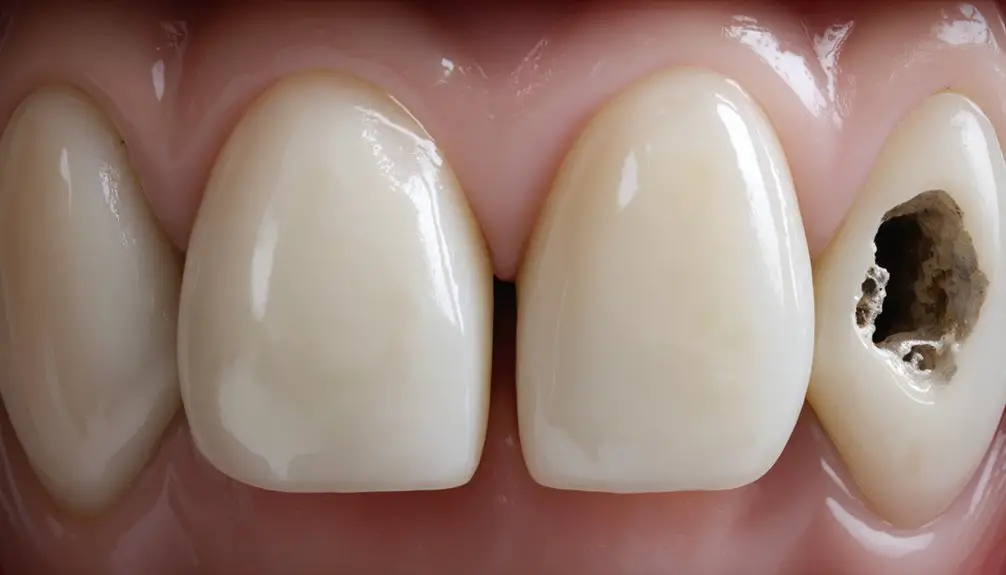
When teeth have compromised enamel or existing sensitivities, safe whitening practices become essential to prevent further dental damage. Following professional at-home guidelines and implementing proper sensitivity management strategies can help you achieve desired results while protecting your dental health.
- Consult your dentist before starting any whitening regimen to assess your teeth’s condition and receive personalized recommendations for products with appropriate peroxide concentrations.
- Use gentle whitening formulations specifically designed for sensitive teeth, avoiding highly concentrated bleaching agents.
- Apply desensitizing toothpaste before and after treatments to protect your enamel and minimize discomfort.
- Monitor your teeth’s response during whitening, and if you experience increased sensitivity or gum irritation, pause treatment immediately and contact your dental professional.
Remember to avoid combining multiple whitening methods, as this can accelerate enamel wear and increase sensitivity.
Long-Term Effects on Dental Health
The long-term impacts of teeth whitening extend far beyond immediate cosmetic results, particularly affecting the structural integrity of dental enamel.
When you whiten teeth with untreated cavities, you’re accelerating potential long-term consequences that can compromise your oral health.
Repeated exposure to whitening agents on decayed teeth will progressively weaken your enamel, potentially leading to tooth extraction in severe cases.
Your focus should be on enamel preservation through proper cavity treatment before considering any whitening procedures.
Without addressing decay first, you’ll face increased risks of chronic sensitivity, recurring infections, and structural damage that can greatly reduce your teeth’s lifespan.
These cumulative effects often result in more extensive and costly dental procedures, ultimately threatening both the function and aesthetics of your smile.
Prevention Strategies During Whitening Treatment
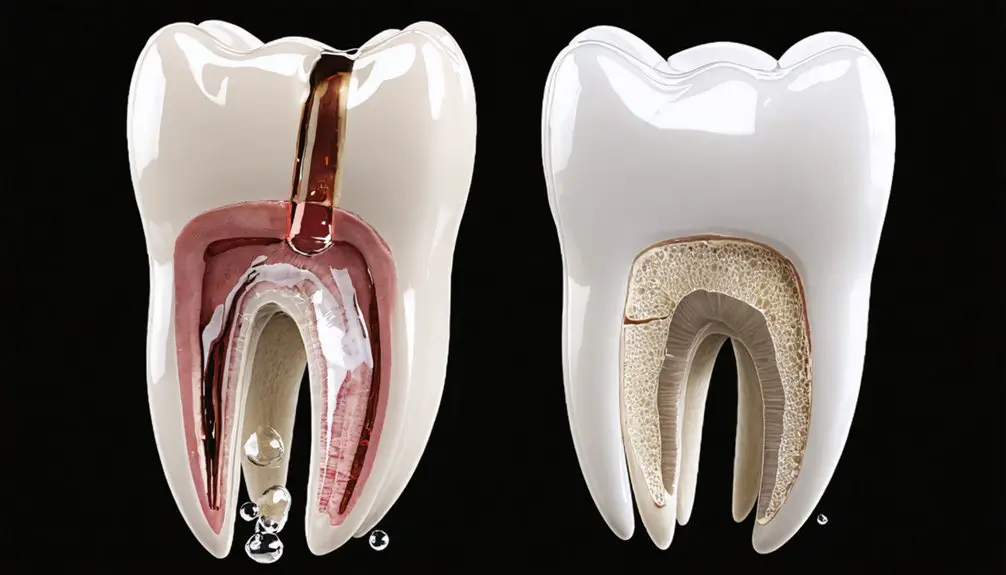
Maintaining ideal oral health during teeth whitening requires a thorough prevention strategy that addresses multiple risk factors.
You’ll need to implement specific protective measures to safeguard your enamel while achieving desired whitening results.
- Monitor your whitening frequency carefully, allowing sufficient intervals between treatments for enamel recovery and remineralization through fluoride applications.
- Make dietary adjustments by reducing acidic and sugary foods, while increasing calcium-rich options to support enamel strength.
- Practice meticulous oral hygiene with gentle fluoride toothpaste, daily flossing, and antiseptic mouthwash to minimize bacterial growth.
- Undergo professional dental assessment before treatment to address existing cavities and receive customized guidance on appropriate whitening protocols for your specific dental condition.
Treatment Options for High-Risk Patients
Patients with high-risk dental conditions require specialized treatment approaches before pursuing teeth whitening procedures. If you have untreated cavities, you’ll need restorative care through composite fillings, crowns, or root canal therapy before considering any bleaching treatments.
For cases where whitening isn’t recommended, alternative treatments like dental bonding, porcelain veneers, or full coverage crowns can effectively improve aesthetics while protecting compromised teeth.
Patient education plays an essential role in treatment planning. You’ll learn about customized protocols that may include lower concentration bleaching gels, shorter application times, and the use of desensitizing agents.
Your dentist will monitor sensitivity levels and adjust treatments accordingly. They’ll also document your informed consent after explaining potential risks and establishing realistic expectations for your specific dental condition.
Frequently Asked Questions
Can Whitening Toothpaste Prevent New Cavities While Brightening Teeth?
You’ll get both whitening effectiveness and cavity prevention when using fluoride-containing whitening toothpaste, as it removes surface stains while strengthening enamel through remineralization and plaque reduction.
How Long Should I Wait After Filling a Cavity Before Teeth Whitening?
You’ll need to wait 1-2 weeks after your filling for ideal whitening safety. This filling duration guarantees proper healing and material integration before proceeding with any bleaching treatments.
Does Whitening Affect the Strength of Temporary Dental Crowns?
Like acid rain eroding stone, whitening agents weaken your temporary crown’s durability through surface softening and microhardness reduction. You’ll risk compromising its structural integrity and shortening its functional lifespan.
Can Certain Foods Help Neutralize Bleaching Agents’ Effects on Sensitive Teeth?
You’ll reduce tooth sensitivity from bleaching agents by consuming calcium-rich dairy, white meats, and mild starches. These dietary choices promote remineralization while non-acidic foods help neutralize whitening chemicals.
Is UV Light Teeth Whitening Safer for People Prone to Cavities?
Like playing with fire, UV light teeth whitening isn’t safer for cavity-prone teeth. You’ll face increased sensitivity, potential nerve damage, and weakened enamel. For UV safety and cavity prevention, choose non-UV alternatives.
References
- https://pmc.ncbi.nlm.nih.gov/articles/PMC11120504/
- https://pmc.ncbi.nlm.nih.gov/articles/PMC8352057/
- https://www.frontiersin.org/journals/dental-medicine/articles/10.3389/fdmed.2021.687507/full
- https://health.clevelandclinic.org/is-teeth-whitening-safe
- https://www.nature.com/articles/sj.bdj.2013.1047
- https://pmc.ncbi.nlm.nih.gov/articles/PMC10814888/
- https://pmc.ncbi.nlm.nih.gov/articles/PMC4058574/
- http://www.scielo.sa.cr/scielo.php?script=sci_arttext&pid=S2215-34112024000100086
- https://www.nature.com/articles/s41405-024-00253-0
- https://onlinelibrary.wiley.com/doi/10.1155/2024/6893472
